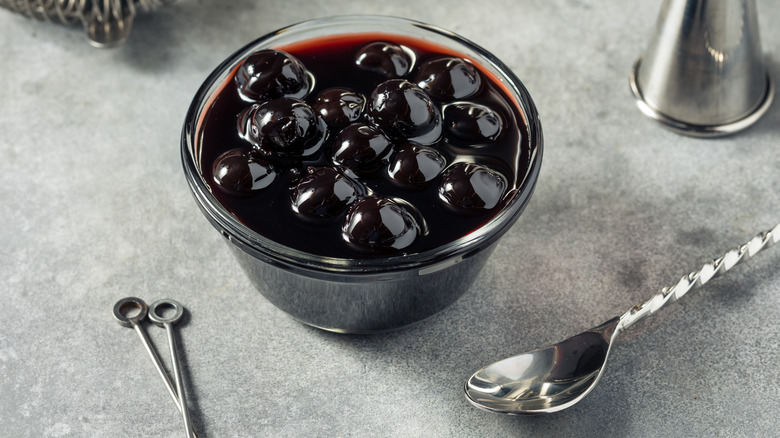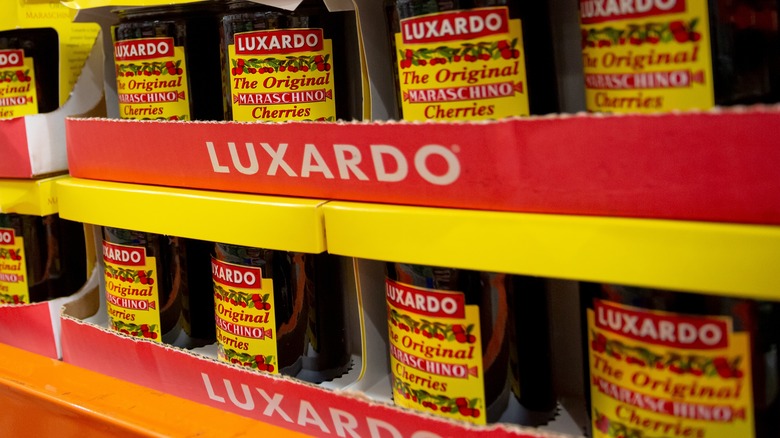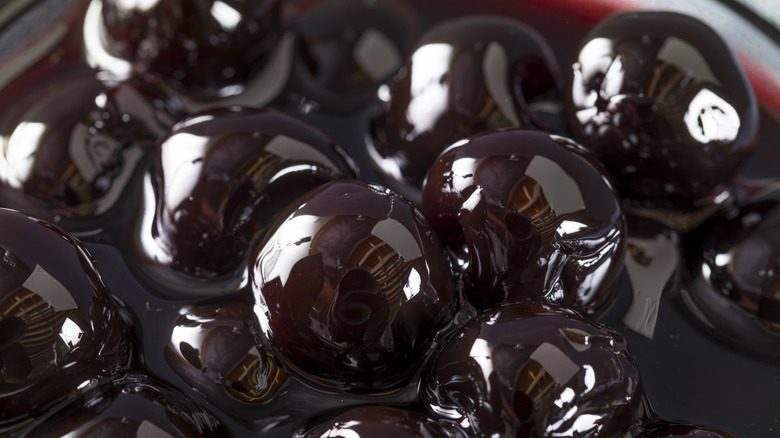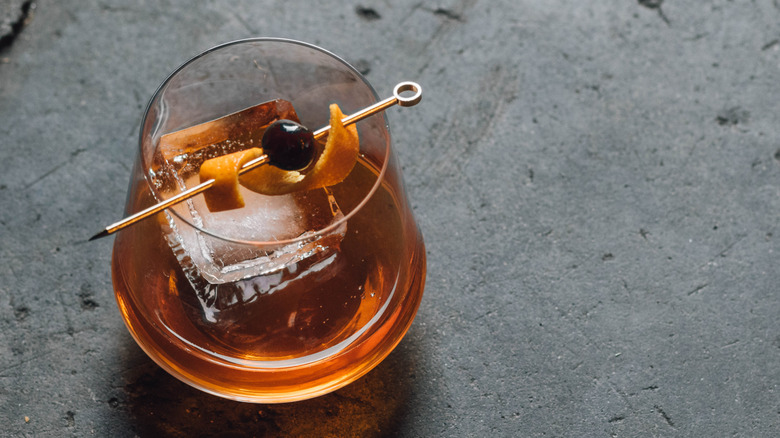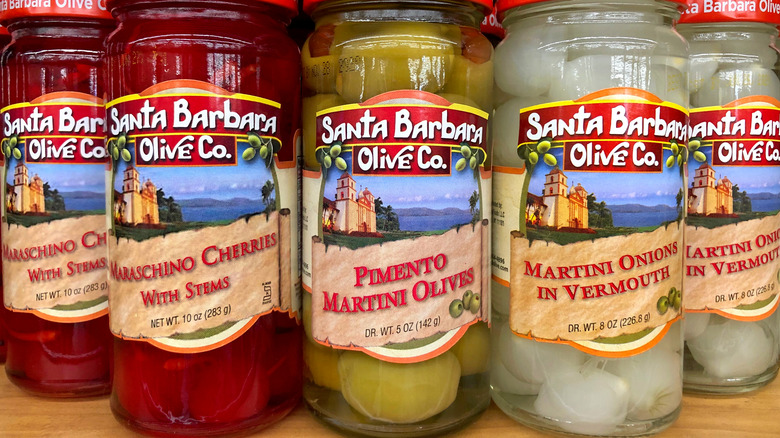What Makes Luxardo Maraschino Cherries Special?
There is a time in most people's lives when maraschino cherries seem like the fanciest, most exceptional thing they've ever tasted. That time is typically childhood, when mom lets you order your first Shirley Temple, or when you've graduated from a kid's scoop at the ice cream parlor to a hot fudge sundae. Those neon red cherries still attached to their equally red stems might as well be jeweled crowns as they sit atop the whipped cream, waiting to be cherished. As you get older, though, maraschino cherries lose their luster. Sure, they show up in your cocktails when you grow up, but the magic has diminished.
But, the magic comes back if you've happened to be a customer at a reputable cocktail lounge — or the patron of a good mixologist. These places and people still use maraschino cherries as there are many cocktails that just aren't complete without their signature garnish. But there is a difference in the type of cherries they use.
It is common for those serious about their cocktail game to only use Luxardo Maraschino cherries. If you've tasted one, you probably remember that childhood magic coming right back. At first, you're surprised, then stunned at the flavor of these orbs that, truthfully, look nothing like the maraschinos you're used to. You want the flavor to linger because it's so spectacularly special. And, right then and there, you make the decision to never have another kind of maraschino in your Manhattan again.
An Italian treat that began in Croatia
Every jar of Luxardo maraschino cherries is adorned with a bright yellow label featuring rows of red cherries on branches and the words "Made in Italy." Indeed, the cherries have been made in Torreglia, Italy — about an hour's drive from Venice — for nearly 80 years. However, they were initially produced in a region of Croatia called Dalmatia, which borders the Adriatic Sea. In 1817, Girolamo Luxardo moved to the city of Zara in Dalmatia from Sardinia with his family and began his legacy in 1821 by making a maraschino liqueur, which garnered international acclaim. As time went on and the company thrived, it produced other liqueurs and, in 1905, began making the Original Maraschino Cherries.
For decades, Luxardo continued to prosper and supply the world with their goods, but during World War II, its factory was nearly obliterated by constant bombings. Several Luxardo family members disappeared or were killed during this time. Refusing to let his family's legacy vanish, Giorgio Luxardo (Girolamo's brother) and fifth generation family member Nicolò III left Dalmatia, taking with them a sapling of a Marasca cherry tree and the family's recipe for the Maraschino liqueur. They settled in the Veneto region of Northwestern Italy in 1947 and began to rebuild their distillery.
Thanks to a loyal, hardworking family, existing positive relationships with distributors, and a rock solid reputation around the world, Luxardo rose again and has been a part of distinguished cocktail culture ever since.
All maraschinos aren't created equal
The extravagant Luxardo Maraschino Cherries begin with the Marasca cherry, which is smaller in size than most cherries. Underneath its thin skin lies a fruit that is so purple, it's sometimes mistaken as black. It is very juicy, but more acidic than sweet. The fresh cherries are soaked in a sweet syrup made from the same cherries to the point where they become candied. In each jar, the cherries are suspended in an exceptionally thick syrup that is completely natural and made without preservatives or thickeners. So dark that they could easily be mistaken for black olives, Luxardo cherries have a noticeable crunch or snap you feel once you bite into it that gives way to an intense, pure yet complex cherry flavor. Tart and sweet at the same time, they are like no other cherry — fresh or otherwise — that you've ever tasted.
Meanwhile, American maraschino cherries are usually made of lighter colored cherries, such as Rainier, Royal Ann, or Gold varietals. Looking to replicate the flavor of the Italian maraschino cherries in the 1920s, an American horticulturist named Ernest Wiegand developed the bright red versions that we are most familiar with today. Using a process of brining that involved calcium salts, sugar, sweet cherries, almond flavoring, and red dye, he created the glowing, sugary spheres that certainly please the taste buds and the kid in all of us, but don't resemble their predecessors at all, from the color to the flavor.
For cocktails, and much more
The Luxardo family, who still runs the Luxardo company today, make it easy for people to figure out what to do with their maraschino cherries. On their jars, written next to the words, "Made in Italy," are the words, "Ideal for Cocktails." It makes sense that the company whose first product was a liqueur created a garnish that was perfect for drinks. Any cocktail that calls for a maraschino cherry would be even better by using a Luxardo. This is partly because of the sweet syrup, which inevitably stays coated on each individual cherry as you pull it out of the jar. It adds a touch of tart Amaretto flavor to whatever you're drinking. Sours, Aviations, and Rob Roys are just a few of many drinks that would be instantly bolstered by the magic of Luxardo.
Luxardo cherries are certainly not limited to alcoholic beverages. The cherries are completely appropriate for ice cream sundaes, as garnishes for cakes and desserts, and you could drop one in your lemonade, or eat them out of the jar. And don't forget about the rich syrup that remains in the jar once the fruit is gone. Use it as a substitute for simple syrup, to make a sauce for duck, or top your waffles with it.
Elusive, but attainable
Before you run out and grab yourself a jar (or five) of Luxardo cherries, be advised that they are significantly more expensive than the maraschinos you find in the ice cream aisle of the supermarket. And you're not likely to find them in said supermarket anyway. Created with cocktails in mind, you have a much better chance of finding Luxardo Maraschino Cherries in a good wine and spirits store nestled alongside brined olives and pearl onions. If they do happen to be in a well-stocked supermarket, they'll be in the liquor section.
Some gourmet and specialty markets may sell the cherries, as well as kitchen stores that carry food items. When all else fails, online shopping is always a reliable source. Amazon sells both jars and large cans of Luxardo cherries, with one 400-gram jar going for $24.50.
Costly and potentially difficult to find, you may think these Italian treats can't be worth the hassle of getting your hands on some. That's up to you to decide but before you swear off the search for good, order a drink garnished with a Luxardo during your next happy hour. Make your decision after that.
